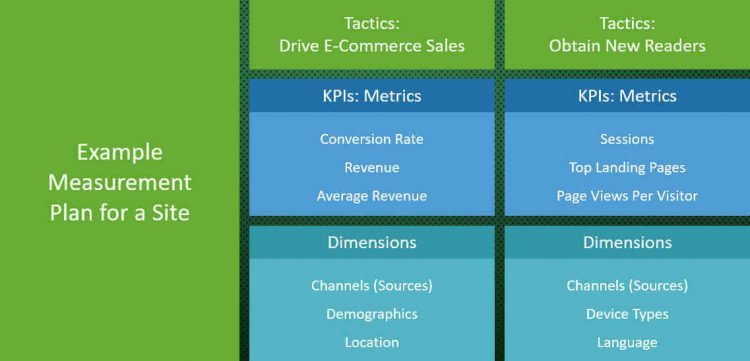You can’t manage what you don’t measure. But how do you know what your analytics should measure?
In this episode of our popular Here’s Why digital marketing video series, Eric Enge gives you four fundamental principles that should define your approach to analytics.
Don’t miss a single episode of Here’s Why. Click the subscribe button below to be notified via email each time a new video is published.
Resources
- Eric’s course for O’Reilly Media: Understanding Google Analytics –From Beginner to Advanced in One Day
- See all of our Here’s Why Videos | Subscribe to our YouTube Channel
Transcript
Mark: Eric, we often hear if you can’t measure it, you can’t improve it. So it would seem that analytics would be a critical concern for anyone doing digital marketing since that’s the way we measure.
Eric: So true, Mark, and yet so many marketers fail to take full advantage of the metrics and data that they collect on a regular basis.
Mark: Why do you think that is?
Eric: To me, the failure starts at a philosophical level; that is these marketers don’t have a well-defined approach to how they implement and use their analytics.
Mark: What would a winning analytics philosophy look like?
4 Fundamentals of Effective Analytics
Eric: I think it’s made up of four fundamental principles.
The first is to set your goals on tracking revenue as closely to direct measurement as you possibly can. Ideally, that would be a situation where you can directly attribute each dollar of revenue to a well-defined source or a distinct path through multiple sources. You should build your goals and attribution models in your analytics to get as close to that direct measurement as you can.
Of course, it isn’t always possible to get a direct measurement. No analytics program can see everything that contributes to a conversion. So, it’s more important to develop an attribution strategy.
By careful observation over time, you can get to know the relative proportions of conversions that come from each of your channels. Then calculate your average transaction values and use those to calculate an attribution distribution for your conversions that you can’t directly track.
If you can’t get direct measurement, see if you can approximate it. For example, if you know your average value per transaction and you can track total transactions, you can estimate revenue. Or if you know the average value per visitor, you can also estimate revenue that way. Then you could tie that back to channels and other dimensions to see what’s the most impactful one for your revenue.
[Tweet “For analytics, your goal should be to track revenue as directly as possible, and formulate reasonable attribution models where it’s not. Learn more at” quote=”For analytics, your goal should be to track revenue as directly as possible, and formulate reasonable attribution models where it’s not.”]
Mark: Okay. So what’s next in your analytics philosophy?
Eric: The second part of a winning analytic philosophy is developing a measurement plan. While revenue is your goal, for most businesses at least, and the most important thing to measure therefore, there are many stepping stones on the way to that goal and measuring them can be useful too.
Mark: What would be some elements you’d include in a measurement plan?
Eric: Here’s a measurement plan I created for my complete course on Google Analytics for O’Reilly Media.

Some of the things that I think worth building into a plan might be eCommerce sales; KPI’s such as conversion rate, revenue and average revenue per transaction or per day or per channel; dimensions such as channels, demographics, locations, device types and languages; whether it’s coming from new versus returning visitors, sessions, total sessions, top landing pages, pages per view.
These are all things that can go into a measurement plan. And what you want to do with your measurement plan is pick the metrics and dimensions that best fit your business goals, but be thoughtful about it upfront.
[Tweet “To do analytics right, you have to have a measurement plan. What’s that? Find out at”]
Mark: So, what about segmentation?
Eric: Funny you should ask, because my third principle is segment, segment, segment.
Segmentation helps you slice into your data in different ways that can reveal new insights. You should segment by channels, of course, but there are many other things that you can look at also: the location where users are coming from, the language they’re using, and device types that they’re using. Screen size is another area.
There are many different types of segments you can set up. You need to fit them to the needs of your business. You need to think that whole process through. So spend the time to experiment to learn what segments are interesting to you and which provide the most value.
Segmentation can help you figure out how different audiences are responding to your site. With this information, you can then tune your content to your various audiences.
[Tweet “Segmentation can help you figure out how different audiences are responding to your site. Learn more at”]
Mark: And the fourth and final principle?
Eric: Well, that would be not shortchanging your investment and getting your analytics set up right. I can’t overemphasize the importance of this one. If you do a bad job setting things up, then you’re going to get bad data in return. And that will lead to bad decisions for your business.
Mark: What would be some examples of implementation mistakes?
Eric: One would be not using UTM tracking codes on links from email or other channels. Not doing that properly will come through looking like direct traffic, for example, and would skew that data. If you don’t have these set up right, you won’t be able to correctly attribute your conversions, a key thing.
Another is not setting up cross-domain tracking. For example, let’s say you’re an eCommerce site, and your shopping cart actually is on a shopping service, a payment service of some kind. So the conversion actually happens on a different domain.
If you don’t have proper cross-domain tracking in this scenario, and you have traffic that comes in on your regular site, but the actual closing the transaction happens on this payment service, those conversions won’t be properly attributed to the right channel. So, this is a really big problem.
Another big issue is not setting up goals or not setting them up correctly. It’s important to identify real goals to set up such as conversions, obviously. But they also might be a call being initiated or a contact form request of some sort. Without goals, you aren’t able to track all your important conversion points.
And finally, and this one is very common, failing to use annotations to track when changes were made to the site that might affect visits, conversions, analytics, etc. Most analytics programs allow you to add dated annotations. They can be really useful when there’s some sudden drastic change in your metrics. An annotation might provide a clue that to what change you made that caused a problem on the site.
Mark: Thanks, Eric. Obviously, analytics is a complex topic. And if you’re like me you’re feeling like you don’t know enough about it. That’s why I want to recommend you check out Eric’s complete course in Google Analytics published by O’Reilly Media.
Don’t miss a single episode of Here’s Why. Click the subscribe button below to be notified via email each time a new video is published.
See all of our Here’s Why Videos | Subscribe to our YouTube Channel


While I think the article is helpful, honestly I haven’t even set up my analytics yet, so I think I will have to read the article again after I have learned the basics.